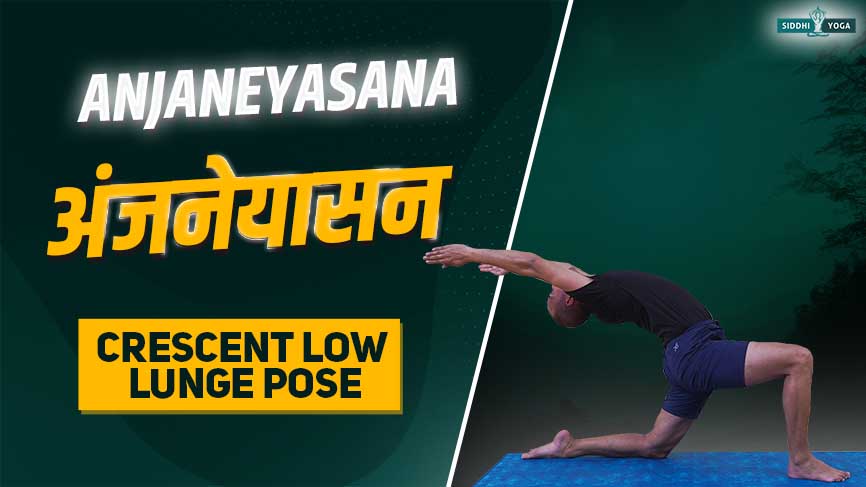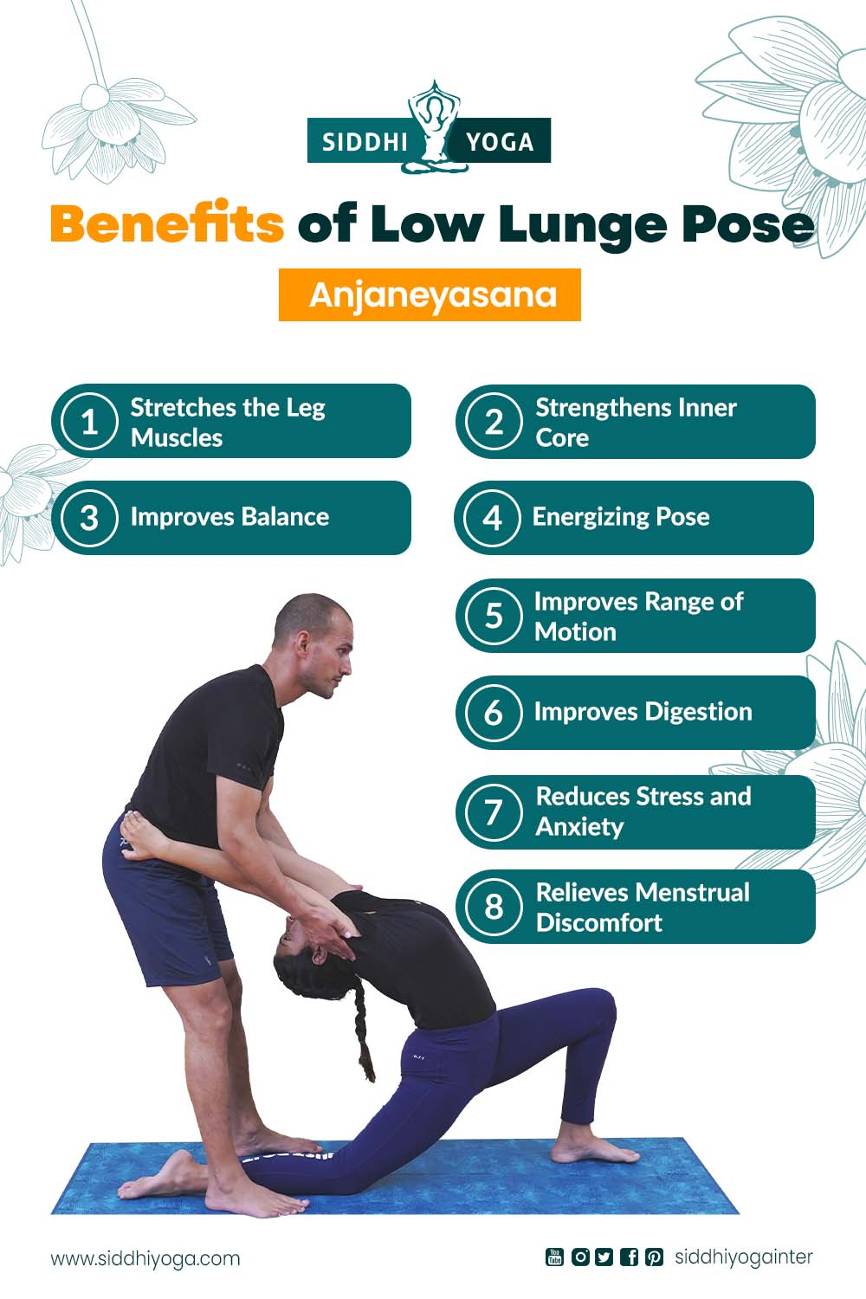
asana: Pose
Anjaneyasana at a Glance
“Anjaneyasana” is named after lord Hanuman’s mother “Anjani”. It mainly focuses on the glutes, hamstrings, and hips.
Benefits:
- This pose stretches the hip flexors, quadriceps, and groin muscles, helping to improve flexibility in the hips and thighs.
- Anjaneyasana engages the muscles of the legs, core, and back, which helps to build strength.
- The pose requires good balance and stability.
- The lifting of the arms and arching back promotes good chest opening.
- It helps to energize the body as it opens the chest and promotes spine flexibility.
Who can do it?
- People who want good flexibility, beginners to advanced level practitioners and people who want to strengthen their body can practice this pose.
Who should not do it?
- It places excessive pressure on the lower hip and knees so a person with a knee injury should be cautious.
- The pose deeply stretches the hip flexors so people should be cautious with knee injuries.
- A person with high blood pressure should be cautious due to the strain on the cardiovascular system.
- Overarching the back can impose problems related to the back.
- As the pose demands a good stretch on the back and lower part, it may not be comfortable during pregnancy.

Introduction
Anjaneyasana, also called Crescent Lunge Pose or Low Lunge Pose, is a fundamental yoga posture that benefits both strength and flexibility. Anjaneyasana requires a sense of stability, determination, and openness. It is often practiced in various yoga sequences. or on its own. It involves a lunge position, where one leg is forward, the knee bent at a 90-degree angle, and the other is extended back. This pose stretches the whole body with all the muscle groups, making it an excellent choice for warming the body, increasing flexibility, and building strength.
How to Do Anjaneyasana?
Follow the Step-by-Step Procedure
- Begin in a Downward-Facing Dog pose (Adho Mukha Svanasana) or with a standing position.
- Inhale as you bring your right foot forward between your hands. Align your right knee directly over your right ankle. Your toes should point straight ahead.
- As you exhale, gently lower your left knee to the mat. The top of your back foot should rest on the floor.
- Ensure that your right knee is directly above your right ankle and your left knee is comfortably behind your hips. Maintain stability in the pose.
- Pull your navel towards your spine to engage your core muscles to support stability in the pose.
- Inhale as you lift your torso upright. Keep your spine straight and open your chest.
- Keep your arms overhead with your palms facing each other. You can also keep your hands in a prayer position. Do not overarch.
- Exhale as you sink your hips. Your hips should be facing forward. Take deep breaths as you hold the pose. Hold the pose and maintain a steady gaze in front.
- To release the pose, exhale as you lower your arms and place your hands on the mat on either side of your right foot. Inhale as you step back, returning to the starting position.
What are the Benefits of Anjaneyasana?
- Hip Flexor Stretch: This pose deeply stretches the hip flexors, particularly useful for people with sedentary lifestyles.
- Quadriceps Stretch: He stretches the quadricep muscles of the front leg, which reduces muscle imbalances, improves knee flexibility, and opens tight quads.
- Core Activation: Balancing in the pose requires the core to be engaged.
- Increased Hip Flexibility: Hip mobility is improved by practicing this pose regularly.
- Improved Balance and Coordination: The pose requires balance and coordination of the muscles.
- Chest Opening: Lifting the arms and arching the back opens up the chest.
- Energy Boost: As the pose enhances good blood circulation, so is a great energy booster.
- Energetic Activation: The pose is associated with the Manipura (solar plexus) chakra, which is linked to personal power, self-confidence, and vitality, so it activates this chakra.
- Stress Relief: The pose is included in most yoga sequences due to its stress-relieving effect.
- Preparation for Deeper Poses: This pose can be used as a great warm-up for most of the backbend and hip-opening yoga poses.
- Emotional Release: This pose is a hip opener pose, hips where most of the emotions are locked, so it is a great emotional stress relieving pose.
Health Benefits from Anjaneyasana in Fighting Certain Diseases:
- Cardiovascular Health: This yoga pose promotes healthy blood pressure and good cardiovascular health.
- Diabetes Management: The pose enables good insulin secretion in the body. Hence, it is good for diabetic people.
- Respiratory Conditions: The chest opening enables a good respiratory system for people with asthma.
- Musculoskeletal Health: It helps strengthen muscles, improve flexibility, and promote better posture, thus reducing the risk of back pain or muscular stiffness.
- Stress and Anxiety: Focused deep breathing helps to reduce stress and anxiety.
- Autoimmune Disorders: It can help with inflammation, stiffness, joint mobility, and reducing inflammation.
- Digestive Health: As the core is engaged, digestive health is maintained.
- Hormonal Balance: Its effects on the solar plexus chakra (Manipura) may contribute to hormonal regulation, good endocrine system, and hormonal balance.
- Immune System Support: Due to its stress-reducing effect, it helps to support a good immune system.
- Aging and Osteoporosis: The pose helps to maintain good spinal health, thereby reducing aging and helping in conditions like osteoporosis.
Safety and Precautions
- Knee Injuries: Knee injuries may worsen if the pose is not properly aligned.
- Hip Injuries: Anjaneyasana involves hip flexion and extension, so deep lunging can worsen this condition.
- High Blood Pressure: The legs are extended in the pose, so there’s a risk of increasing blood pressure due to the exertion required.
- Balance Issues: The pose demands balance and stability. Individuals with severe balance issues, vertigo, or dizziness might struggle to maintain the pose safely.
- Back Issues: The deep backbend should be done with proper care and slowly, or else it may give back issues.
- Pregnancy: There is a strain on the core and pelvic area, so it should be done with utmost care during pregnancy.
- Recent Surgery: People with recent surgery should do it with a good certified yoga practitioner.
- Osteoporosis: A person with this condition should not go for deep backbends.
- General Discomfort: The pose should not be pushed fast. It has to be done slowly.
- Unfamiliarity: People new to yoga should not put any strain on their knees.
Preparatory Poses
- Vrksasana
- Balasana
- Ananda Balasana
Tips for Anjaneyasana
- Begin with a gentle warm-up. Move through simple stretches and dynamic movements to awaken your muscles and joints. You can also do some warm-ups with Surya Namaskar.
- Ensure your front knee is directly above your front ankle.
- Keep your hips squared and facing forward.
- If uncomfortable in a lunge, place a folded blanket or cushion under your feet for extra padding and support.
- Pull your navel gently toward your spine to engage the core muscles for stability and balance.
- The spine should be straight and open to breathing passage. The gaze should not strain the neck.
- Breathe deeply and modify the pose as comfortable. Do not be in a hurry to exit the pose.
Anjaneyasana and the Breath
- Stand in Tadasana or downward facing dog, inhale and exhale, extend your right foot forward and your arms raised over your head.
- Inhale and Exhale bend your right foot, keeping the correct alignment of the foot. Keep your chest lifted and shoulders relaxed. Palms can face each other. Keep the left foot flexed and engaged with your core involved.
- Inhale and Exhale, lower your right knee to the ground, and find balance. Maintain a few deep breaths in the pose and relax. Rest the top of the back foot on the floor.
- Hold the pose for a few deep breaths, and inhale and exhale. Release the pose slowly by releasing the right foot and returning to the starting position.
- Repeat the same steps switching legs.
Physical Alignment Principles of Anjaneyasana
- In this pose, rest your back foot on the floor comfortably and the bent knee should not be too out to give you any strain. Maintain a straight spine with a gaze in front.
- Keep your shoulder and neck relaxed and your navel pulled in. With deep breathing, elongate your spine. Your hands and core should be involved. Relax in the pose and use props wherever needed.
Common Mistakes
- Start with a few stretches for hips, shoulders and neck.
- Use yoga block if needed. Keep your chest lifted and your back foot flexed and engaged.
- Maintain a straight spine with a natural curve. There should be a gentle backbend. Keep your shoulder blades relaxed. Do not overach your spine.
- Engage your core and keep the alignment of your bent foot proper with your knee and ankle in a straight line.
- Maintain deep breaths.
Anjaneyasana and Variations
- High Lunge Variation
- Twisting Anjaneyasana
- Aṣṭāvakrāsana (Split Variation)
- Lateral flexion Variation
- Anjaneyasana with Backbend
- Dynamic Anjaneyasana
- Supported Anjaneyasana
- Wall Anjaneyasana
- Props variation
- Follow-up Poses
- Adho Mukha Svanasana (Downward-Facing Dog)
- Uttanasana (Standing Forward Fold)
- Ardha Uttanasana (Half Forward Fold)
- High Plank Pose
- Chaturanga Dandasana (Four-Limbed Staff Pose)
- Urdhva Mukha Svanasana (Upward-Facing Dog)
- Adho Mukha Svanasana (Downward-Facing Dog)
- Virabhadrasana I (Warrior Pose1)
- Virabhadrasana II (Warrior Pose2)
- Trikonasana (triangle pose)
- Parivrtta Parsvakonasana (Revolved Side Angle Pose)
Follow-Up Poses
- Virabhadrasana 1
- Virabhadrasana 3
FAQs
Why is Anjaneyasana Important?
The asana helps to tone internal organs and maintains good digestive health.
Is Anjaneyasana a Backbend Pose?
This pose helps to deepen the backbend by enhancing the spine flexibility.
Which muscles are used in Anjaneyasana?
This asana targets ankles, chest, glutes, hip flexors, knees, spine muscles, and calves. Hamstrings, quadriceps, and shoulders.
Take Away
Anjaneyasana invites us to stretch our thigh muscles and reach beyond our limitations. Through the gentle bend of the back knee and the grounding of the front foot, this asana teaches us the art of balance — the equilibrium between effort and surrender, strength and flexibility. With each inhalation, we elongate our spine and open our chest to embrace life’s challenges. With each exhalation, we sink deeper, release tension, and offer gratitude for the present moment. Our energy aligns, and our inner fire ignites confidence and willpower. Anjaneyasana is not merely a physical posture; it’s a journey through the layers of body, mind, and spirit. meet them.
Yoga is not just a practice; it’s a way of life. Take the first step towards a meaningful career by enrolling in our comprehensive online yoga teacher training courses. Choose from 200-Hrs Yoga Teacher Training, 300-Hrs Yoga Teacher Training, or 500-Hrs Yoga Teacher Training Programs – all crafted to help you master the art of teaching yoga. Embrace your passion, become a certified yoga instructor, and empower others to find their inner peace and strength.